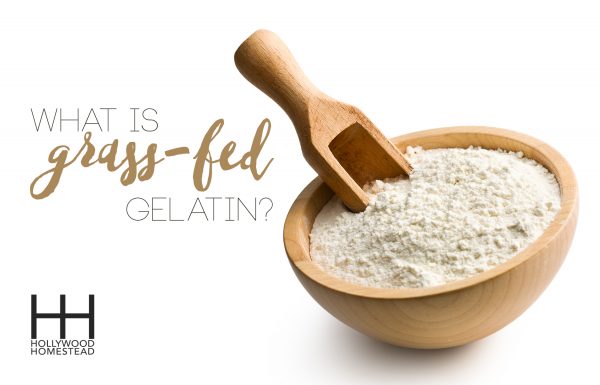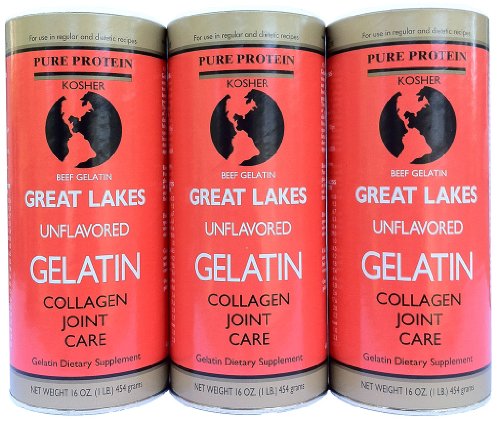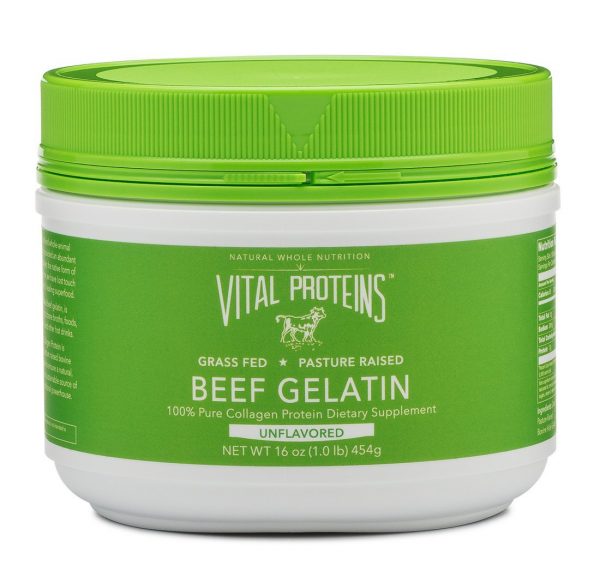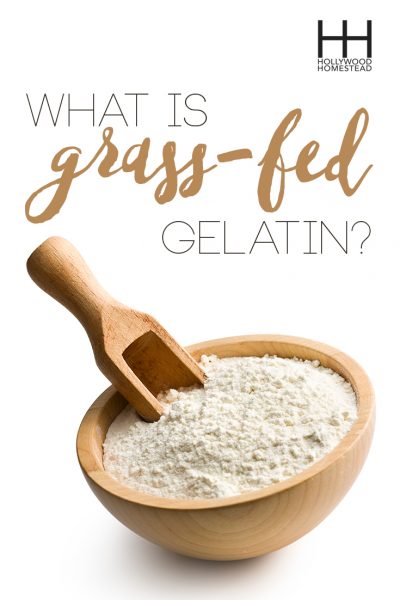
By now, you have probably heard of the many health benefits of gelatin which range from weight loss to to fighting wrinkles (and much more in between).
Just in case you haven’t heard about how amazing gelatin is yet, you can get my eBook The Gelatin Secret. It has comprehensive information about what gelatin is, its many benefits, and lots of recipes to help you consume more gelatin.
But, as is the case with any superfood, quality matters. This is why people seeking to improve their health choose grass-fed gelatin.
What Does Grass-Fed Mean?
You probably have seen the term grass-fed on meat packaging in the supermarket. According to the Agricultural Marketing Service of the USDA, the term grass-fed is used with ruminant animals such as cows and sheep.
In order for a product to be labeled grass-fed, the animal must have only eaten grass and only grass for its entire life after it stopped drinking its mother’s milk.
The labeling standard also said that the animal must have had continuous access to pasture during the growing season.
Unfortunately, the AMS withdrew this labeling standard in January 2016. They said that it was impossible for them to check whether the animal had really been eating just grass its entire life, so they basically gave up on trying to enforce any labeling regulations!
That means the term “grass fed” on products has as much legal weight as terms like “natural” and “free range” – both of which are also not regulated.
This is really disappointing news for anyone who cares about food quality. You basically have to trust the company is being truthful when they put the grass-fed label on their gelatin. Or, you have to dig deeper to make sure the company is actually using grass-fed cows for their gelatin.
What Grass-Fed Does NOT Mean
I know, food labels can be so confusing!
Grass-fed simply means that the animals have eaten grass and nothing but grass. The label has nothing to do with organic because the grass could have been sprayed with pesticides.
Grass-fed does not mean hormone-free. The cows could have been given hormones.
Grass-fed also is not the same as pastured. Note that the old grass-fed requirements did state that the animal had to have access to pasture during the growing season. However, there was no definition of how many hours per day they needed to have access, nor any strict definition of “growing season.”
Pastured doesn’t really have any proven health benefits (the proven benefits are from eating grass, not from going outdoors). However, it is a commonly-held belief that pastured meat products will be healthier because, unlike animals which live in cramped feedlots, they won’t be as susceptible to disease from the crowded conditions.
There is also the issue of Vitamin D. Just like humans, cows produce vitamin D in response to sunlight. Without access to the outdoors, animals can suffer vitamin D deficiency. As can be read here and here, this is apparently a big problem. The cows end up with health problems like rickets and poor immunity. Unfortunately, there isn’t any solid research (that I could find) on how lack of sunlight affects the nutrition of the meat we eat. But we can infer that unhealthy cows = less nutritious meat.
Further, a lot of people choose pastured products for moral reasons too because they don’t want to support terrible factory farms.
You might see the term “pastured” on gelatin brands. Like with grass-fed, there is no legal requirement as to what this label means. However, with trustworthy brands, it should mean that the animal had access to pasture during the entire year.
Why Choose Grass Fed?
By nature, cows are supposed to eat grass. Unfortunately, most cows today are not raised on their natural diet. Instead, 78% are raised in terrible CAFOs (concentrated animal feeding operations), aka factory farms.
There are three main reasons that CAFO cows aren’t eating grass.
- They don’t have outdoor access. It is cheaper for farmers to keep cows confined to smaller spaces. If the cows do go outside, it is regulated to feedlots.
- Corn subsidies make it cheaper to feed cows corn than grass. Yes, crazy but corn is actually cheaper than grass for farmers!
- Corn makes cows fatter. And they get fat faster. For factory farmers who want to maximize production at the expense of animal welfare and quality, corn feed is the way to go.
If you want to learn more about this, I suggest reading this great article about grass-fed beef.
In addition to the moral issues that come with eating factory farm animals, there are also many health reasons to choose grass-fed products.
Health Benefits of Choosing Grass-Fed
Recently, there has been a lot of scientific research which backs up the nutritional benefits of choosing grass-fed meat over grain-fed meat.
In my opinion, one of the biggest reasons is because of the fatty acid profile of the resulting meat. As Chris Kresser talks about here and Dr. Axe talks about grass-fed meat has higher amounts of CLA, a potent antioxidant.
The difference is so large that grass-fed beef has 2x to 3x the amount of CLAs than grain-fed beef!
Grass-fed meat also has:
- More vitamins and minerals including iron, vitamin E, B vitamins, and carotenoids
- More antioxidants
- A better Omega 3 to 6 ratio
- Lower levels of saturated fat
Unfortunately, I haven’t been able to find any specific studies about the health benefits or nutritional profiles of grass-fed gelatin vs. grain-fed gelatin. However, studies such as this one (PDF) talk about how the source of the gelatin can impact nutrition. So, since grass-fed beef is so much more nutritious, we can assume that the gelatin produced from these same animals would also be more nutritious and healthy.
Which Grass-Fed Gelatin is Best?
Remember, as of 2016, the label “Grass Fed” no longer has any legal requirements and the USDA isn’t checking to make sure the animals actually are fed only grass.
For that reason, it is really important that you are choosing a brand that you can trust.
There are only two brands of gelatin that I feel really confident recommending: Great Lakes Kosher Gelatin and Vital Proteins Collagen Peptides. There are probably other good brands of gelatin but I personally don’t know enough about them to feel confident recommending them.
Great Lakes Kosher (Bovine) Gelatin

This is the brand of gelatin that I’ve been using for years and have had great results with it. They’ve had the grass-fed label since before the 2016 USDA label change. So, it is safe to assume that their bovine gelatin really is grass-fed. Only cow hides are used for making the gelatin.
Note that Great Lakes also makes porcine gelatin. This gelatin is a bit cheaper, but there is no guarantee that the pigs were fed a healthy diet. For this reason, I would go with the Kosher gelatin.
***You can buy Great Lakes Gelatin here***
Vital Proteins Gelatin

Vital Proteins is newer on the scene and it has become very popular in the paleo-sphere. Just like with Great Lakes, only cow hides are used for making the gelatin. It is a bit pricier than Great Lakes. However, as far as quality goes, they have a lot more information about how their cows are raised and how their gelatin is made.
The gelatin is grass-fed, pastured, and free of GMOs, antibiotics, and hormones. I also like that they will provide you with a Certificate of Analysis which proves that the product wasn’t contaminated. On their website, they even state that their cows get 2.67 acres of pasture each. So, this is definitely a high-quality grass-fed gelatin. The only downside is that it does cost a bit more.
***You can buy Vital Proteins gelatin here***
Prefer a Gelatin which Doesn’t Gel?
Collagen is the exact same thing as gelatin except that it doesn’t gel. Since it is flavorless and odorless, you can add it to almost any liquid — such as your morning coffee or tea. This makes it even easier to add gelatin to your diet. Learn more about the difference between gelatin and collagen here.
***Buy Great Lakes Collagen Here***
***Buy Vital Proteins Collagen Here***
Want to learn more about gelatin? Download my book The Gelatin Secret. You’ll get information on the health benefits of gelatin, how to use it, and lots of great gelatin recipes to incorporate it into your life. Buy the book here.


Latest posts by Sylvie McCracken (see all)
- Treating H. Pylori (Part 3): What H. Pylori Does to the Body - August 8, 2022
- Treating H. Pylori (Part 2): How H. Pylori is Contracted - August 3, 2022
- Understanding Beef Labels: Organic, Pastured, Grass-Fed & Grain-Finished - July 25, 2022
GREAT INFO! AND DO YOU HAVE SOME RECIPES WITH GELATIN IN IT?.